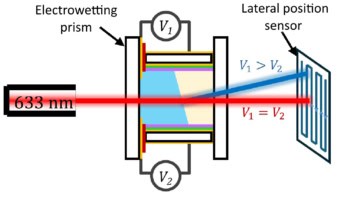
The internal magnetic compasses of migratory birds can be disrupted by weak, man-made electromagnetic interference, according to a new study carried out by researchers in Europe. The unexpected effect was seen in European robins, which were unable to orient themselves in the presence of broadband, radiofrequency noise believed to be caused by AM radio and electronic signals.
Despite having been known for over half a century, the exact mechanism behind “avian magnetoreception” – a sense that in theory allows migratory birds to detect a magnetic field and so perceive direction – is poorly understood. Regardless of how it is done, the birds’ talent is easily demonstrated using an Emlen funnel – a device that records the direction in which entrapped birds attempt to take off. The funnel is shaped like an inverted cone and lined with an inkpad at the bottom. When placed into the funnel, night-flying songbirds instinctively attempt to escape in the direction of their current migratory path and this is traced along the sides of the cone, which is lined with paper.
Avian compass
When using this method to study European robins kept inside wooden huts, however, Henrik Mouritsen from the University of Oldenburg and colleagues were puzzled to find that their birds seemed unable to orient themselves as expected. Given previous theories that robins might be affected by radiofrequency magnetic fields, the researchers experimented with reducing local electromagnetic noise by screening the birds’ huts with electrified and grounded aluminium plates. This shielding reduced the interference by two orders of magnitude, while leaving the static geomagnetic field unaffected. The impact on the birds was striking – a surprising restoration of their orientation abilities.
“What we wanted to study originally was exactly where in the brain this magnetic compass information is processed in these night-migratory birds,” says Mouritsen. The interference effect was seen by chance, Mouritsen notes, adding that they “realized that [if the effect] was really due to the electromagnetic background noise, then that would be very interesting in its own right” – and would also be useful for understanding the exact magnetoreception mechanism behind the avian compass.
Seven-year scrutiny
To verify their observations, the researchers ran repeated experiments over a seven-year period and tests were conducted double-blind to avoid bias. Initial tests – using two screened huts, where only one was actually grounded and the experimenters were unaware of which – confirmed the role of the screening out of the interference in the restoration of the birds’ sensory abilities. Subsequently, the team exposed the robins – within shielded huts – to similar electromagnetic noise of their own creation, and this was also seen to leave the animals disorientated.
Peter Hore, a chemist at the University of Oxford who is part of Mouritsen’s team, told physicsworld.com that while the mechanism by which the Earth’s magnetic field could affect the outcome of a chemical transformation (the mechanism via which the avian compass is thought to work) is well understood, “we’re talking here about man-made fields that are two to three orders of magnitude weaker…so what we don’t know is whether this is a direct effect”.
Stretching limits
By varying the frequency of the electromagnetic noise, the team was able to determine that the interference was disruptive over a broad range of frequencies, from 20 kHz up to 5 MHz. Electromagnetic noise in this range, the researchers write, is commonly caused by the operation of electronic equipment and AM radio signals – but not, they note, from mobile phones or power lines, whose fields fall outside this frequency range. While the man-made, electromagnetic noise seems to be too weak to disrupt the bird’s compass outside of urban settings, the researchers question the impact such noise might be having on the numbers of night-migratory songbirds, which are in decline.
Mark Denny, co-author of the book Engineering Animals, points out that the “magnetic orientation sense of European robins is disabled by broadband magnetic fields with strengths as low as 1 nT…this is four and a half orders of magnitude below the geomagnetic field strength”, thereby stretching the limits of what was previously thought biophysically possible.
The research is described in Nature.



